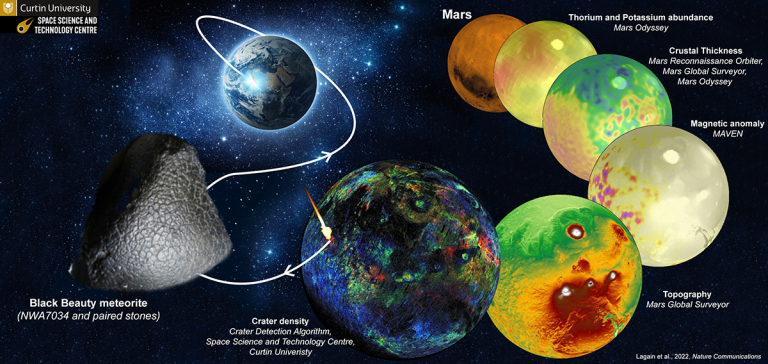What a Martian meteorite can teach us about Earth’s origins
Researchers found the martian origin of the 4.48-billion-year-old Black Beautymeteorite, whose origin is one of the oldest regions of Mars.

[July 16, 2022: Heidi Toth, Northern Arizona University]
More than 4.5 billion years ago, it’s possible the Red Planet had a crust comparable to Iceland today. (CREDIT: Curtin University)
What do Mars and Iceland have in common?
These days, not so much. But more than 4.5 billion years ago, it’s possible the Red Planet had a crust comparable to Iceland today. This discovery, hidden in the oldest martian fragments found on Earth, could provide information about our planet that was lost over billions of years of geological movement and could help explain why the Earth developed into a planet that sustains a broad diversity of life and Mars did not.
These insights into Earth’s past came out of a new study, published in Nature Communications, by an international team that includes an NAU researcher. The study details how they found the likely martian origin of the 4.48-billion-year-old meteorite, informally named Black Beauty. Its origin is one of the oldest regions of Mars.
“This meteorite recorded the first stage of the evolution of Mars and, by extension, of all terrestrial planets, including the Earth,” said Valerie Payré, a postdoctoral researcher in the Department of Astronomy and Planetary Science. “As the Earth lost its old surface mainly due to plate tectonics, observing such settings in extremely ancient terrains on Mars is a rare window into the ancient Earth surface that we lost a long time ago.”
'Black Beauty' meteorite fragment (CREDIT: Northern Arizona University)
Related Stories:
What Mars can tell us about Earth
The team, led by Anthony Lagain from Curtin University in Australia, searched for the location of origin of a martian meteorite (officially named NWA—Northwest Africa—7034 for where it was found on Earth). This meteorite, the chemistry of which indicates that Mars had volcanic activity to that found on Earth, recorded the first stage of Mars’ evolution. Although it was ejected from the surface of Mars five to 10 million years ago after an asteroid impact, its source region and geological context has remained a mystery.
This team studied chemical and physical properties of Black Beauty to pinpoint where it came from; they determined it was from Terra Cimmeria-Sirenum, one of the most ancient regions of Mars. It may have a surface similar to Earth’s continents. Planetary bodies like Mars have impacts craters all over their surface, so finding the right one is challenging. In a previous study, Lagain’s team developed a crater detection algorithm that uses high-resolution images of the surface of Mars to identify small impact craters, finding about 90 million as small as 50 meters in diameter. In this study, they were able to isolate the most plausible ejection site—the Karratha crater that excavated ejecta of an older crater named Khujirt.
“For the first time, we know the geological context of the only brecciated Martian sample available on Earth, 10 years before the NASA’s Mars Sample Return mission is set to send back samples collected by the Perseverance rover currently exploring the Jezero crater,” said Lagain, a research fellow in the School of Earth and Planetary Sciences at Curtin. “This research paved the way to locate the ejection site of other Martian meteorites, in order to create the most exhaustive view of the Red Planet’s geological history."
a Perspective view (Context Camera mosaic21) and cross-section through Karratha along a SW-NE axis (Supplementary Fig. 5b) as interpreted from numerical modelling simulations. Shades of colors denote impactites (impact melt and in situ breccia; ejecta and fall-back breccia). b Schematic of chronological events experienced by the host terrain of the regolith breccia. (CREDIT: Northern Arizona University)
Payré studies the nature and formation of Mars’ crust to determine if Earth and Mars share a common past that include both a continent-like and ocean-like crust. She uses orbital observations captured in this region to investigate whether traces of volcanism similar to Iceland exist on Mars.
a Global context of the 19 crater candidates and location of provinces and rovers (yellow triangles) referred to in the present study. Background: Mars Orbiter Laser Altimeter (MOLA) shaded relief. b, c: Magnetic field intensity and remanent magnetization at the surface from ref. 27. d, e Potassium and Thorium concentration at the surface from ref. 28,30. Beige area corresponds to discarded provinces due to the weathered basaltic surface contribution (Methods). (CREDIT: Northern Arizona University)
“As of today, Mars’ crust complexity is not understood, and knowing about the origin of these amazing ancient fragments could lead future rover and spatial missions to explore the Terra Sirenum-Cimmeria region that hides the truth of Mars’ evolution, and perhaps the Earth’s,” she said. “This work paves the road to locate the ejection site of other martian meteorites that will provide the most exhaustive view of the geological history of Mars and will answer one of the most intriguing questions: why Mars, now dry and cold, evolved so differently from Earth, a flourishing planet for life?”
The team’s algorithm is adapted to detect impact craters constellating Mercury and the Moon, the other terrestrial bodies. This can be used to help unravel their geographical history and answer foundational questions regarding their formation and evolution. This work is a starting point to guide future investigations of the Solar System.
For more science and technology stories check out our New Discoveries section at The Brighter Side of News.
Note: Materials provided above by Northern Arizona University. Content may be edited for style and length.
Like these kind of feel good stories? Get the Brighter Side of News' newsletter.
Joshua Shavit
Science & Technology Writer | AI and Robotics Reporter
Joshua Shavit is a Los Angeles-based science and technology writer with a passion for exploring the breakthroughs shaping the future. As a contributor to The Brighter Side of News, he focuses on positive and transformative advancements in AI, technology, physics, engineering, robotics and space science. Joshua is currently working towards a Bachelor of Science in Business Administration at the University of California, Berkeley. He combines his academic background with a talent for storytelling, making complex scientific discoveries engaging and accessible. His work highlights the innovators behind the ideas, bringing readers closer to the people driving progress.



